Gluten-free substitute for bulgur or burghur is a must if you’re cutting gluten but still want that hearty, nutty grain vibe. Whether it’s tabbouleh or grain bowls, we’ve got the best swaps that cook well, taste great, and totally work in your favorite dishes.
From quinoa to buckwheat and even teff, you’ll learn how to cook them, why they’re healthy, and how to use them like a pro. Plus, don’t miss our easy gluten-free biscuits or delicious sandwich ideas if you’re craving more gluten-free goodness.
Understanding Burghur: What You Need to Know
So, what is burghur or bulgur? Simply put, it’s a whole grain made from cracked durum wheat. It’s commonly used in Mediterranean and Middle Eastern dishes—for example, in tabbouleh and pilaf. What makes bulgur unique is that it’s parboiled, dried, and ground into various sizes. Because of that, it cooks significantly faster than many other whole grains.
In addition, bulgur is packed with nutrients. It’s rich in fiber and essential vitamins like magnesium and iron, which help with digestion and boost overall health. Moreover, its nutty flavor and chewy texture make it a fantastic base for salads, grain bowls, and warm sides. Ultimately, it’s a go-to for adding heartiness and nutrition to your meals. If you’re curious about how bulgur compares to other grains, learn more about its inflammatory potential or find out if bulgur is truly gluten-free.
What is a gluten-free substitute for Burghur?
Understanding what burghur is becomes essential, especially for those seeking gluten-free options. To begin with, it’s a whole grain commonly found in salads, side dishes, and main courses. Not only that, but it also offers a chewy texture and a distinct nutty flavor. Because of its versatility and nutritional benefits, it’s a popular choice in many cuisines.
Exploring Burghur’s uses helps find gluten-free substitutes. These substitutes should have similar qualities.
Definition and Uses of Burghur
Burghur comes from cracked whole wheat, parboiled, dried, and ground. It’s used in tabbouleh salad, pilafs, and soups. It adds a hearty base or a nutritious touch to dishes.
You can use it in many recipes. From stuffed vegetables to grain bowls, it’s versatile.
Nutritional Benefits of Burghur
Burghur is great for those watching their health. It’s full of fiber, which helps digestion. It also has protein for muscle growth and repair.
It’s packed with antioxidants too. These fight inflammation and boost health. Finding a gluten-free substitute with these benefits is important.
Popular Gluten-Free Substitute to Burghur
Looking for gluten-free options? You’ll find many wheat-free grains that can replace Burghur. These grains have similar textures and flavors to bulgur. They also bring new nutritional benefits to your meals. If you’re wondering which ones are safest and most nutritious, discover which grain has the least gluten for smart substitutions.
Overview of Gluten-Free Grains
Quinoa, millet, buckwheat, and brown rice are great choices. Each has its own special qualities:
- Quinoa: It cooks fast and tastes nutty. It’s packed with protein and fiber.
- Millet: This seed is full of nutrients and easy to cook. It’s perfect for many dishes.
- Buckwheat: It has a slightly bitter taste but is rich in fiber. It’s a great substitute.
- Brown Rice: It’s versatile and gluten-free. It takes longer to cook but has a chewy texture.
Benefits of Switching to Gluten-Free Options
Switching to gluten-free alternatives has many benefits. You might see:
- Improved gut health thanks to more fiber.
- More nutrients with a variety of vitamins and minerals.
- Less inflammation, which helps your overall health.
Exploring these gluten-free options, on the whole, can make your meals more flavorful and textured. By incorporating these grains, you’re adding variety while also boosting your overall nutrition. As a result, you’ll enjoy a more diverse and healthy diet that perfectly aligns with the long-term benefits of a gluten-free lifestyle.
Quinoa: A Top Gluten Free Choice for Substitute to Burghur
Quinoa is a fantastic choice if you’re looking for a reliable gluten-free Burghur substitute. Not only is it naturally gluten-free, but it also brings a nutty flavor and fluffy texture that fits well in both savory and sweet dishes. In fact, quinoa works wonderfully in meals where bulgur might be traditionally used—making the switch almost seamless. For creative ideas, don’t miss our gluten-free chicken stir-fry that pairs perfectly with quinoa.
Cooking and Preparation Tips
Before anything else, start by rinsing your quinoa thoroughly. This helps remove saponins, which can leave a bitter aftertaste. To do this easily, using a fine mesh strainer works best—this stainless steel set is a solid pick on Amazon. For best results, use a 2:1 ratio of water to quinoa. First, bring the water to a boil, then stir in the quinoa, reduce the heat, and cover.
Let it simmer for about 15–20 minutes until all the water is absorbed. Finally, fluff it with a fork to create a light and airy texture. Want to take it up a notch? Cook it in vegetable broth for extra flavor or try adding it to this hearty gluten-free breakfast casserole for a power-packed morning.
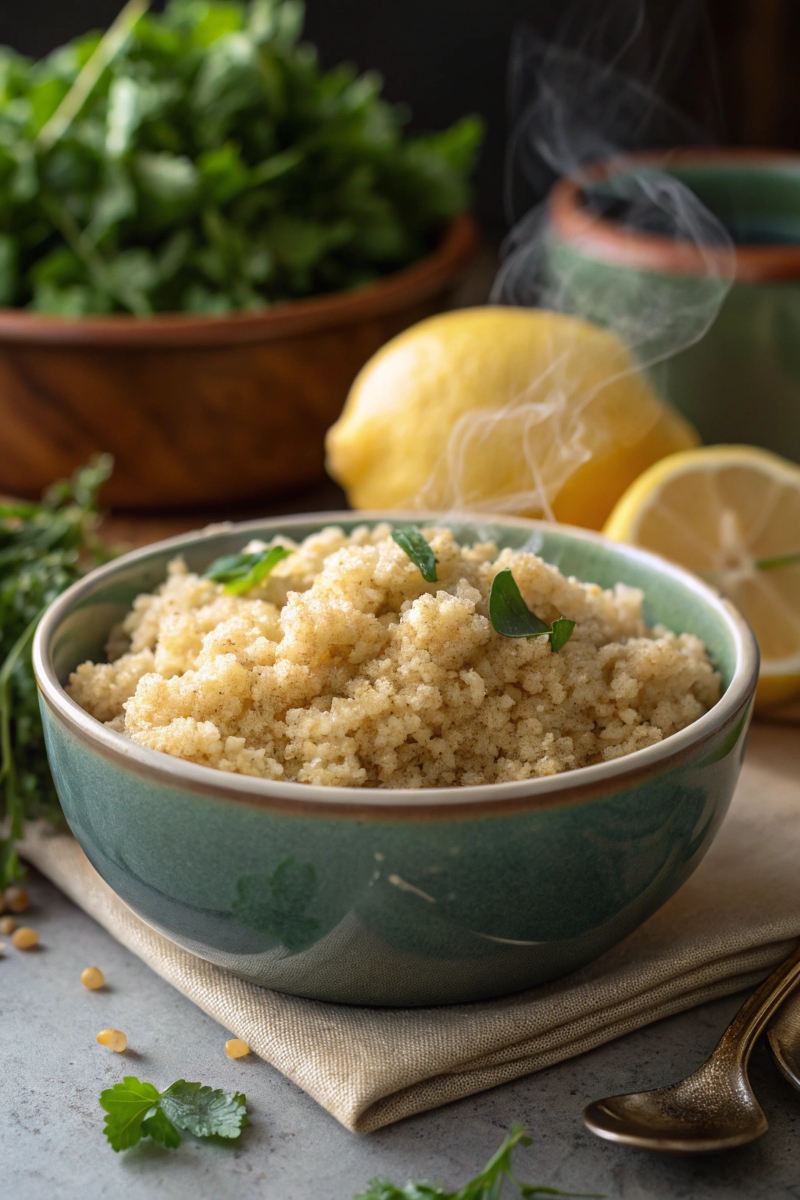
Nutritional Profile of Quinoa
From a nutritional standpoint, quinoa is hard to beat. It contains 12–18% protein, which makes it a great option for anyone on a protein-rich or vegetarian diet. Additionally, each serving offers about 6 grams of fiber, supporting better digestion and long-lasting fullness.
Moreover, quinoa is a solid source of iron, magnesium, and zinc—minerals that support energy levels, muscle function, and immune health. Its lower glycemic index compared to bulgur also helps regulate blood sugar, making it a smart pick for those with insulin sensitivity. Looking to compare other gluten-free grains? Check out which grain has the least gluten for even more choices.
Buckwheat Groats: Nutritional and Culinary Aspects
Buckwheat groats are a great choice when you compare them to bulgur. They are gluten-free and have a strong, nutty taste. This makes them perfect for many dishes. Plus, they are full of vitamins and minerals, making them very healthy.
Why Choose Buckwheat Groats?
Choosing buckwheat groats has many benefits:
- Rich in nutrients: They have a lot of protein, about 13-15% per serving. They also have important minerals like manganese, magnesium, and phosphorus.
- High in fiber: With 10-12 grams of fiber per 100 grams, they help with digestion and keep you full.
- Low glycemic index: They have about 70-75 grams of carbs per 100 grams. This helps control blood sugar, making them good for many diets.
- Heart health benefits: Rutin and quercetin in buckwheat may lower cholesterol, which is good for your heart.
- Low in fat: With less than 2 grams of fat per 100 grams, they are good for your heart.
How to Cook Buckwheat for Perfect Results
Cooking buckwheat is easy. Just follow these steps:
- Rinse the buckwheat groats under cold water to remove any impurities.
- Add 1 cup of groats to 2 cups of boiling water or broth in a saucepan.
- Reduce the heat to low, cover, and simmer for about 20 minutes or until the liquid is absorbed.
- Fluff with a fork and let it sit covered for an additional 5 minutes before serving.
Cooking buckwheat keeps it chewy. It’s great in salads, grain bowls, and soups. This gluten-free grain is versatile and healthy, making it a good choice instead of bulgur.
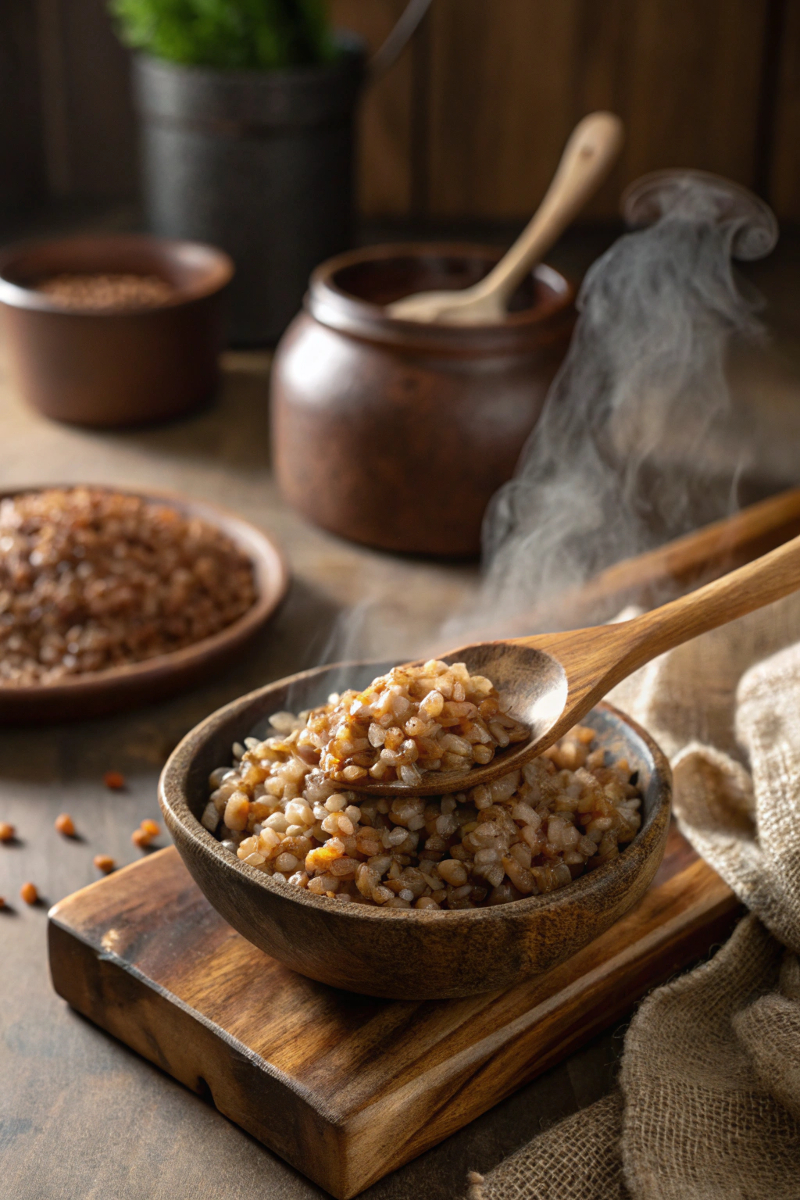
Millet: A Versatile and Easy-to-Cook Alternative
Adding millet to your cooking can really change things up, especially as a bulgur substitute. This small, round seed tastes mild and slightly nutty. It becomes fluffy when cooked, making it great for many dishes. Plus, cooking millet is easy and quick, perfect for those who need gluten-free options.
Flavor and Texture Comparison to Burghur
Millet and burghur are different in flavor and texture. Millet has a gentle nutty taste that adds to dishes without taking over. Its light, fluffy texture is a nice contrast to burghur’s heartiness. This makes millet perfect for salads, bowls, and pilafs, offering many recipe possibilities.
Recipes Utilizing Millet
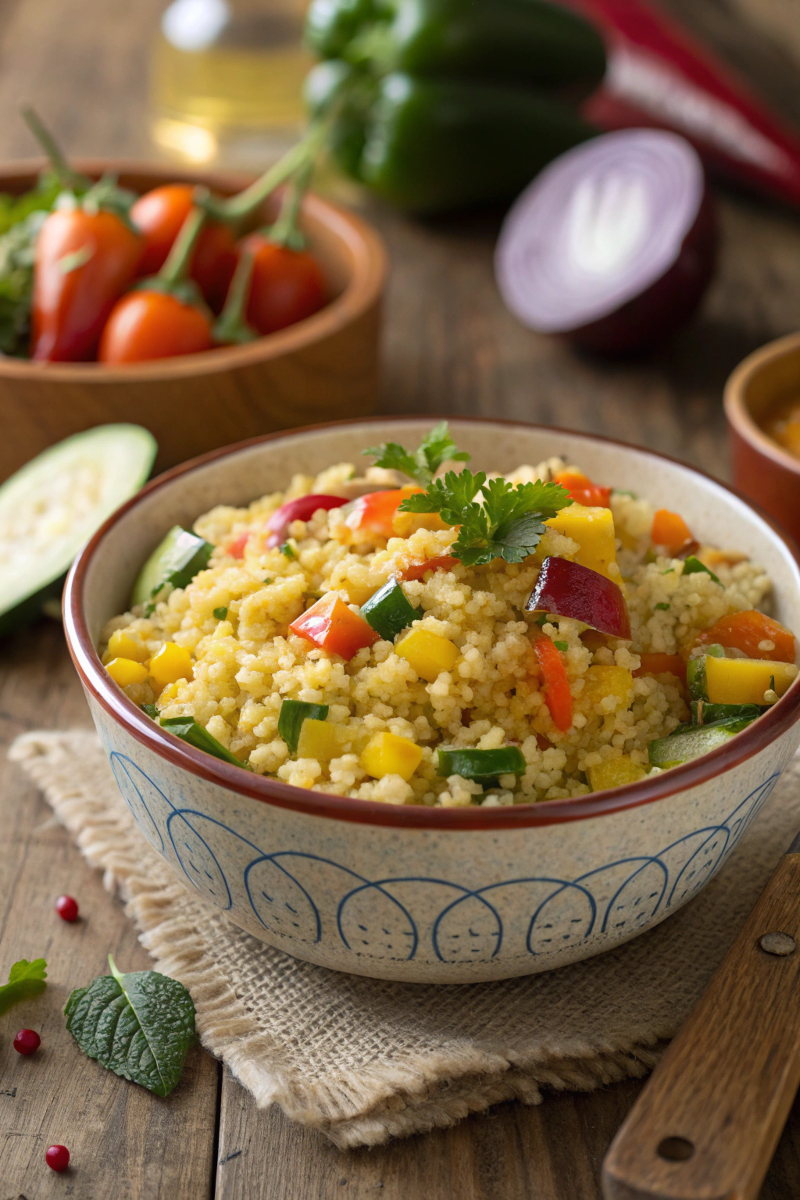
Millet can be the star of your cooking. Here are some tasty millet recipes to try:
- Millet Pilaf: Mix cooked millet with sautéed veggies, herbs, and spices for a filling side dish.
- Millet Salad: Combine cooked millet with chickpeas, cucumbers, cherry tomatoes, and a zesty lemon dressing.
- Millet Breakfast Bowl: Top warm cooked millet with fruits, nuts, and honey for a healthy breakfast.
Brown Rice: Accessibility and Cooking Methods
Brown rice is a great substitute for bulgur, being gluten-free. It has a nutty taste and a chewy texture. This makes it perfect for many dishes. It’s also easy to find and use in your cooking.
Types of Brown Rice for Cooking
There are different types of brown rice, each with its own traits. The two main types are:
- Long-Grain Brown Rice: This type stays fluffy and not too sticky. It’s great for pilafs and salads.
- Short-Grain Brown Rice: This variety is starchier and stickier. It’s best for risottos and sushi.
To cook brown rice, use a 2:1 water-to-rice ratio. This results in fluffy grains after 30 to 45 minutes of cooking.
Nutritional Benefits of Brown Rice
Brown rice offers many health benefits. It has more fiber than white rice, which helps with digestion and energy. It’s also packed with nutrients like:
- Magnesium
- Iron
- Vitamin B6
- Antioxidants
These nutrients help keep your diet balanced. They support your health and make brown rice a good choice instead of bulgur.
Teff: The Tiny Nutritional Powerhouse
Teff is an ancient grain known for its nutritional benefits. It’s a great choice for those looking for a gluten-free option. Despite its small size, teff is packed with nutrients that can make your meals better. Using teff as a bulgur substitute can open up new possibilities in the kitchen.
Cooking Tips for Teff
Cooking teff is easy. Use a 3:1 water-to-teff ratio. First, rinse the teff in cold water to remove impurities. Then, boil the water, add the rinsed teff, and lower the heat to a simmer.
Let it cook for about 20 minutes until the grains soak up most of the water. Season it as you like to add flavor. This way, you get fluffy grains perfect for various recipes.
Culinary Uses of Teff in Traditional Dishes
Teff is versatile, especially in traditional Ethiopian cuisine. It’s great for making injera, a fermented flatbread that’s a staple in Ethiopian meals. Teff can also be added to soups, salads, and baked goods for extra nutrition.
Its mild, nutty flavor works well with both sweet and savory dishes. This makes it a fantastic ingredient to try in your cooking.
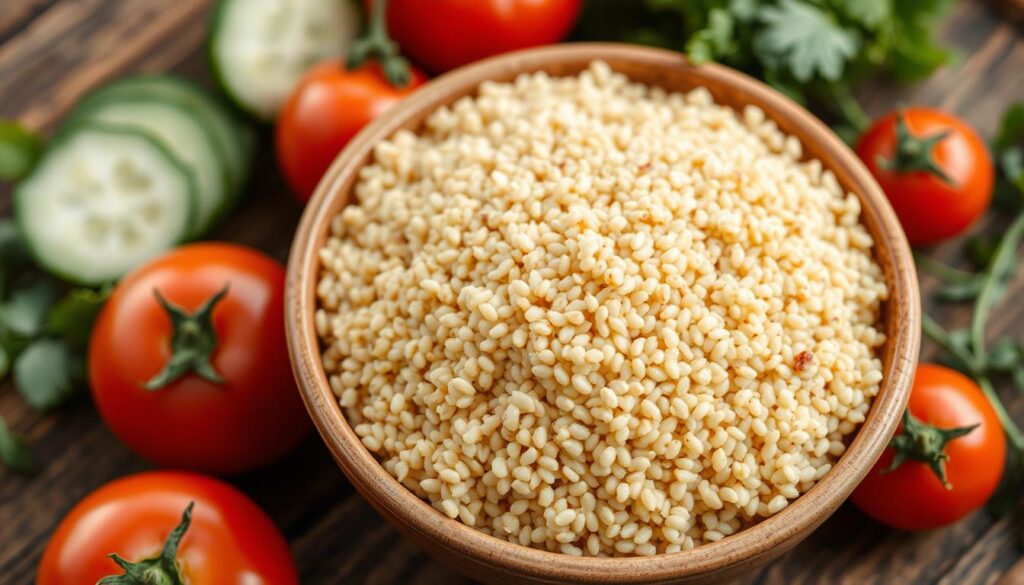
Amaranth: A Nutritious Pseudo-Grain
Amaranth is becoming more popular as a gluten-free substitute for Burghur. It has a great nutritional profile. Its unique texture and high nutrient content make it stand out, especially when compared to bulgur.
Health Benefits of Amaranth
Amaranth is packed with protein, fiber, and important nutrients like lysine. It’s great for muscle health, digestion, and heart health. Its sticky texture when cooked adds flavor and nutrition to dishes.
How to Incorporate Amaranth into Your Meals
There are many ways to add amaranth to your meals. Here are some amaranth recipes:
- Create a hearty salad by mixing cooked amaranth with fresh vegetables and a light dressing.
- Add amaranth to soups for added thickness and nutrition.
- Use it as a base for a grain bowl combined with legumes and greens.
Preparing amaranth is easy. Cook it by simmering one part amaranth with two parts water for about 20 minutes. This way, you get to enjoy its flavor and health benefits while avoiding gluten.
Farro vs. Bulgur: Similarities and Differences
Farro is a tasty alternative to bulgur, with a chewy texture and nutty taste. Both grains have similarities, but their cooking and nutrition can vary. Knowing how to cook and the benefits of each is key if you want to use farro instead of bulgur.
Cooking Techniques for Farro
Farro needs to soak overnight to improve its texture and cut down cooking time. It takes about 25 to 40 minutes to simmer, depending on the type. This is longer than bulgur, which cooks in 10 to 15 minutes.
Farro is great in grain salads or hearty soups. It’s a versatile ingredient that can add depth to many dishes.
Nutritional Values Compared
Farro is packed with protein and fiber, making it a nutritious choice. It has more dietary fiber than bulgur, which is good for your digestive health. Both grains are healthy, but your preference might depend on your diet and cooking ease.
Barley: Is It a Good Substitute?
Barley is a versatile grain known for its chewy texture and nutty flavor. It’s often considered as a possible substitute for Burghur in recipes. To find out if it works, we need to look at the different types of barley and how to cook it right.
Types of Barley and Their Uses
There are many types of barley, each with its own uses:
- Hulled Barley: This whole grain keeps most of its nutrients and fiber, making it healthier.
- Pearl Barley: This polished barley cooks quickly and is soft, great for soups and stews.
- Quick-Cooking Barley: It’s perfect for those short on time, cooking much faster than regular barley.
Cooking Barley: Best Practices
For the best results when using barley as a substitute, follow these tips:
- Use a 1:3 ratio of barley to water for cooking.
- Bring the mixture to a simmer.
- Cook it for about 45 minutes for pearl barley, or follow the package instructions for other types.
Barley is great in soups, stews, and salads. It has a low glycemic index and is full of nutrients. However, barley contains gluten, so it’s not good for those with gluten allergies. For gluten-free options, try quinoa, buckwheat, or millet.
Couscous: A Quick Cooking Alternative
Couscous is loved for its fluffy texture and quick cooking time. It’s made from durum wheat, but you can find gluten-free versions too. These are made from corn or rice, making couscous a great gluten free burghur substitute. To cook couscous, just soak it in boiling water for 5-10 minutes. This makes a dish that’s both quick and delicious.
Differences Between Wheat Couscous and Gluten-Free Options
Wheat couscous and gluten-free couscous differ mainly in ingredients. Wheat couscous has gluten, which is bad for those with gluten issues. Gluten-free couscous, on the other hand, is safe for everyone. It tastes and feels similar to wheat couscous but without the gluten.
This makes gluten-free couscous a great choice for anyone who needs to avoid gluten. Just remember, gluten-free couscous might need a bit more time to cook.
Suggested Dishes Featuring Couscous
Adding couscous to your meals can be very creative. Here are some tasty dishes you can make:
- Couscous Salad: Mix cooked gluten-free couscous with fresh veggies, herbs, and a tangy dressing for a refreshing salad.
- Stuffed Peppers: Use couscous as a filling with ground meat or beans for a hearty stuffed pepper dish.
- Couscous Pilaf: Sauté onions, garlic, and spices, then mix in the couscous for an aromatic side dish.
- Vegetable Stir-Fry with Couscous: Combine stir-fried veggies with gluten-free couscous for a quick and nutritious meal.
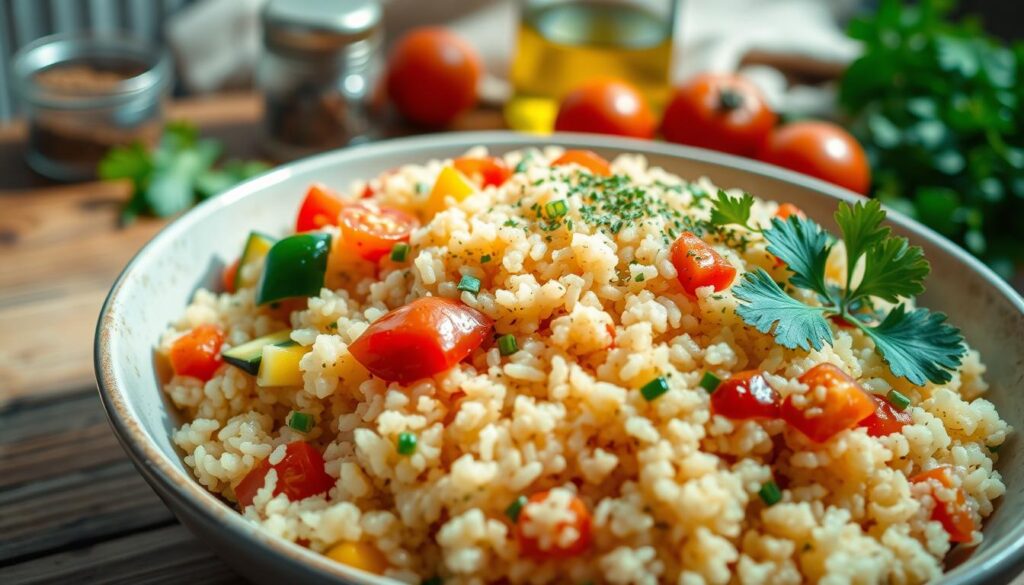
Conclusion:
Exploring a gluten-free substitute for bulgur opens up a whole world of healthy, exciting options. For starters, grains like quinoa, buckwheat, and millet not only simplify meal planning, but they also make your diet more balanced and nutritious.
What’s more, these substitutes allow you to enjoy diverse flavors and textures in your go-to dishes. Plus, they add a unique twist that keeps meals interesting without sacrificing taste.
By understanding how these gluten-free substitutes work, you’re empowered to make smarter choices in the kitchen. In fact, once you get the hang of using them, cooking becomes more creative and satisfying.
Even better, with so many adaptable alternatives available, embracing gluten-free eating becomes less of a challenge and more of an adventure. You get to experiment with new grains, fresh recipes, and bold flavors.
Honestly, healthy eating doesn’t have to feel limiting. On the contrary, when you have the right gluten-free substitute for bulgur, your meals stay flavorful, fun, and fit your dietary needs just right.
Want more inspiration like this? Follow us on Facebook, Instagram, or check out creative meal ideas on our Pinterest page.





